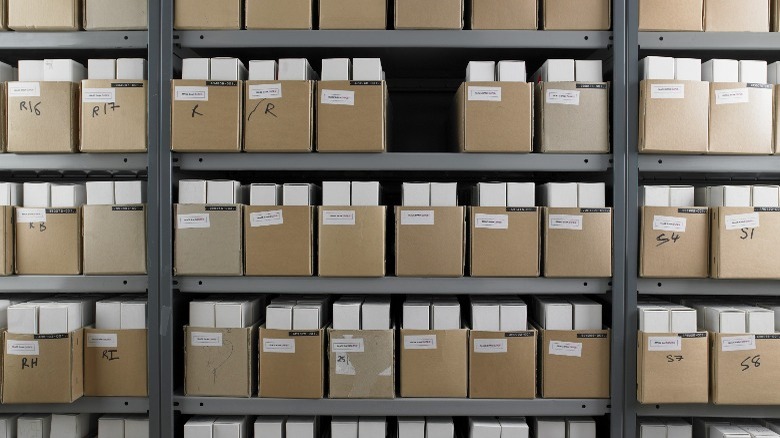11 Best Uses For Old Servers
With the rise of cloud computing, many companies are stuck with a pile of servers that are retired due to dated hardware and software. According to Statista, the top ten global tech companies alone produced over 2.4 million metric tons of waste in 2021.
So if you've also recently replaced an old server and are planning to throw it in the backroom or scrap bin, you can find plenty of uses for it instead. If its hardware is intact you can repurpose it in a bunch of ways ranging from turning it into a web or mail server to transforming it into an archive storage drive. In this article, we'll explore eleven surprisingly useful ways you can repurpose that decommissioned server and make it into something more valuable than gathering dust in a forgotten corner.
Before you decide to move forward with one of these methods, you should consider your old server's hardware, operating system, and security measures and see if they are compatible with the prescribed methods. If your old machine isn't up to the task of computing for scientific research, the least it can do is hold your old photos and movies for easy access.
Turn It Into an Email or IRC Server
If you own or are a part of a small company, it's highly likely that third-party workspaces and communication platforms like Slack, Protonmail, or Google Suite are a part of your tech stack. If you have an old server lying around, you can turn it into an IRC server and use it as your company's third-party communication platform. This will allow you to host your own internal communications system for your team and create customized rules, filters, and other settings tailored to your company's needs.
The process of converting an old server into an email or IRC server is also simpler than it sounds. All you need to do is install an IRC server software like UnrealIRCd or InspIRCd. Then configure the server's hostname, port number, administrator password, and the server's firewall to allow incoming connections on the IRC port.
After the initial setup is complete, you can use the IRC server software to create mailbox quotas, anti-spam measures, and user access privileges. Once all the configuration and setup are complete, you can start it up and begin using it to host IRC channels and chat with your team members.
The best part is that since there is no involvement of a third-party service, it also helps keep your company's sensitive data secure and physically stored within the premises of your company. Not to mention that having your own IRC server can cut down your company's expenses as well, as you no longer have to subscribe to third-party communication platforms.
Use It for Virtualization
Another great way to reuse an old server is to convert it into a virtual machine. If you are not familiar with the concept of virtual machines, you can think of it as software that mimics another operating system. This means that the VM will behave like its own independent computer, even though it's actually running on another computer.
Generally, these VMs can take up a lot of resources on a laptop or a PC, but since you can create a dedicated server for this, you can run them without facing any hardware limitations. In fact, depending on your server's technical configuration, you can create multiple virtual machines at the same time. So, you can run a bunch of processes on each of your server's independent partitions and utilize its processing power and resources.
This can help you in a number of ways. For one, virtualizing an old server can help potentially save thousands of dollars in hardware and software and software costs. It also saves time, as using a virtual machine set up on a server to process a large data set is comparatively much faster and more efficient than doing the same on a PC.
But on the flip side, older servers may not be compatible with the newer versions of some applications. Additionally, they typically consume more power than newer models, which means higher electricity bills. So if you plan on converting your old server into a virtual machine, you should consider the pros and cons based on your use case and proceed accordingly.
Convert It Into a Dedicated Print Server
If your workflow requires printing a ton of pages, converting your old server into a print server might be one of the best ways to reuse it. A print server is basically a hub that interconnects multiple computers to a group of printers connected to a network. This allows users to print from their own devices rather than having to physically connect to the printer.
Now you might be wondering that since you can do that by using the in-built Wi-Fi communication feature of your modern printer anyway, why bother setting up a dedicated print server? Well, there are several reasons why you might want to do that. First of all, most printers that come with Wi-Fi capabilities require you to be connected to the same network in order to access the printer. That's not the case with a dedicated print server, as you can configure it to receive inputs from other network sources as well, meaning that you can print a file in your office's printer from anywhere in the world.
Secondly, it offers improved security as you can control the access to printers to prevent unauthorized printing. This basically adds an extra layer of protection to your company's sensitive data and reduces the risk of confidential documents falling into the wrong hands. You can even create a customized set of user permissions to prevent unauthorized access. Most importantly, having a dedicated print server can help you manage print jobs more efficiently. For example, you can set up rules to route print jobs to the appropriate printer, prioritize important print jobs, and reduce printer downtime by monitoring and maintaining your printers.
Turn It Into a NAS (Network-Attached Storage)
If you have a fair amount of storage space on your old server, you can convert it into a NAS (Network-Attached Storage). This will turn your server into personalized cloud storage that you and your team can access from any part of the world.
NAS may sound like a fancy term, but it's basically a dedicated storage device that connects to a network to provide data storage services to other devices over the Internet. It is essentially a type of hard drive that is connected to a network instead of a computer, allowing multiple users to access the data stored on it.
The best part of having a NAS is that the data is stored on a server that is physically located on your premises, providing you with more control over data security and privacy. In contrast, with cloud storage, the data is stored on servers owned and managed by a third-party provider, so you have to rely on their security measures and policies to protect your data.
Apart from that, since all your data is stored locally on the NAS, it can be accessed and transferred at full speed of the network allowing you faster access to your data and entirely skipping the data transfer limitations imposed by cloud storage services.
Not to mention, this can help you save on the subscription fee charged by cloud storage services as well. Another advantage of NAS is that it is generally more affordable than cloud storage as you're using your own hardware, which can always be expanded by adding additional hard drives.
Use It as an Archive Storage
Almost all organizations have a pile of data that they aren't actively using but is still too important to be thrown away– this is where having an archive storage server comes in handy. By converting your old server into archive storage, your organization can manage its data much more efficiently and ensure its safety.
To convert an old server into archive storage, you will need to first identify the data that you want to keep and transfer it to your old server. Next, install software on the server that is optimized for file archiving, such as Comet or FileHold. Then, configure the server to maximize its storage capacity by creating large partitions and setting up file-sharing protocols and backup and recovery procedures.
After you've configured your server, you can create your own policies that will dictate when to migrate data to archive storage. The best part? Users don't have anything to do with where exactly the data is stored. Whenever you want to access an archived file, you can simply open it through its original file path, and the archive storage will retrieve the file automatically.
You should consider this type of setup, especially if your company is significantly data-driven and produces large amounts of archive data. It would allow you to store large amounts of information without compromising the performance or security of your main servers.
On top of that, it's a pocket-friendly option as all you really need to set up archive storage in terms of hardware is just a server in working condition, which is where your old server comes into play.
Create Your Own VPN (Virtual Private Network)
Most VPN companies claim not to store any user data. However, according to Komando, there have been multiple incidents where the VPN user's data has been leaked so it's safe to say that VPN services are not as safe as they claim to be. So if you're concerned about your online privacy and also have an old server lying around, you can take control of your online security by turning it into a VPN. This will not only give your old server a new lease on life, but it will also provide you with a secure and private way to access the Internet.
The best part? You can create a custom Network Security System tailored to your business needs. And since all the data flows through your company's private server, you can tweak it to log the activity of anyone who connects to the network, giving you more data and control over your team's activity.
Setting up your old server as a Virtual Private Network requires no additional hardware investments. So, not only can your organization create a highly secure network system that matches or even supersedes expensive VPN commercial services, but it can also save big bucks at the same time. And it doesn't matter if your server doesn't have the best specs. As long as it works and is connected to the Internet, you can turn it into your very own VPN server.
Use It as a Personal Cloud Storage
Converting an old server into personal cloud storage can be a cost-effective way to build your own cloud storage solution. It allows you to have complete control over your data and access it from anywhere with an internet connection.
One of the main advantages of using personal cloud storage is that you can customize it to suit your needs. You can choose the amount of storage space you need, the type of files you want to store, and even the security measures you want to implement. This level of customization is not possible with a public cloud storage provider.
Moreover, setting up your own personal cloud space offers enhanced security and privacy compared to public clouds like Dropbox or Google Drive, as you have physical control over the hardware and the software running on it. Additionally, with an old server acting as your own private cloud space, you don't have to worry about data storage limits or bandwidth restrictions. This allows you to store and access as much data as you need without worrying about exceeding any limits.
The best part is that you don't need a lot of technical knowledge to turn your old server into personal cloud storage. All you need to do is install an open-source cloud storage software such as ownCloud or Nextcloud on your server, configure it according to your requirements, and your personal cloud storage will be good to go. Plus, since most open-source file storage software is free, you can create personal cloud storage without having to pay anything.
Backup Your Website
Websites usually require a fast hosting solution, which is why we don't recommend using your old server to actually host your website unless it's really up to date with the latest hardware. However, even if your old server is not capable of hosting a website or has limited uptime, you can always use it to back up your website.
Using an old server as a backup for your website can provide several benefits. One of the main advantages is increased control over your data. With a personal backup server, you have the ability to store and manage your own backups rather than relying on a third-party service. This can be very useful if you have sensitive data on your website and want to ensure that it is kept private.
Another benefit of using an old server as a backup for your website is the added security. A personal backup server can provide an extra layer of protection as you have physical control over the server, including the hardware and the software running on it. This allows you to properly configure and secure the server to prevent unauthorized access. For example, you can install a firewall and password-protect the backups to prevent hacking.
In addition to increased control and security, using an old server as a backup for your website can also save you money in the long run. Rather than paying for a subscription to a cloud backup service, you can use your own hardware and resources to store and manage your backups.
Create Your Own Game Server
If you love playing multiplayer games, you're going to love this. Have you ever shot your opponent at the same time but still ended up dead? Having a dedicated server can change that. Many of the popular games, such as Minecraft, Ark: Survival Evolved, and Garry's Mod, offer dedicated gaming servers that you can set up and customize as you want to experience lag-free gameplay. And what better way to host a multiplayer gaming server than hosting it on an old server?
Turning your old server into a game server has a ton of benefits. For one, having your own game server unlocks an immense scope for customization. Only want to play a certain game mode? Allow only that game mode. Don't want certain weapons in your game? Ban them. Want to use a custom mod pack? Go ahead. Having your own game server practically allows you to do anything you want with the game.
You also get unparalleled ping and reduced latency since dedicated servers offer even smoother gameplay than local servers do (generally less than 20 ms). Even if you don't have a blazing-fast internet connection, as long as your old server doesn't bottleneck, you'll almost never witness any lag.
Apart from that, when you have a dedicated server for gaming, you will virtually experience zero downtime. That's because you will no longer be at the mercy of some service providers who pause the servers whenever an update is required.
Use It for Experimentation
Before making something accessible to the public, it's important to test it yourself. But of course, you don't want to do this experimentation and testing on your main server — and that's where your old server can come in handy.
It'd be a nightmare to find that the new software you introduced into your organization didn't work out as you expected it to, and your whole workflow turned upside down. In that case, you can test that new software on your experimental server first. The best part is that such experimentation doesn't require a lot of computing power or resources unless you're running something very demanding. So, your old server can most likely support it.
If you're rolling out a new update or a feature, you can create a control group and an experimental group on your server. Then, ask users for feedback, and implement that feedback. Once you feel comfortable with the results between the control group and the experimental group, make the feature available to everyone.
Also, if you are a tech professional or a tech student, you can also benefit from using your old server for experimentation. For example, it can be a cost-effective way to test new software or technologies without investing in new hardware. It can also be a good way to learn about operating systems, networking, and other technical skills, as well as provide a safe environment for practicing and developing those skills. Additionally, using an old server for experimentation can help people in tech understand the limitations and challenges of working with older technology, which can be valuable knowledge in a field that is constantly evolving.
Donate Your Server's Power to Science
Philanthropy doesn't always require money. By connecting your old server to a network of other computers, you can contribute towards groundbreaking research in many areas, such as finding the cure for cancer and AIDS, searching for extraterrestrial life, fighting climate change, advancing AI and Cognitive Science, and so much more.
There are many ongoing research projects in different fields of Science that can use all the processing power they can get. For example, organizations such as Folding@home and BOINC use distributed computing to simulate complex biological processes, such as protein folding and drug design. This can help researchers better understand diseases and develop new treatments. Similarly, organizations such as World Community Grid use donated computing power to run simulations and analyses for a variety of research projects, including clean energy research and the search for new cancer treatments.
By donating the computing power of your old server, you can help support these types of important research projects while also finding a new use for your old hardware. All it takes is 5 minutes of installation in exchange for contributing to cutting-edge research. The best part is that there's no need to entirely dedicate your server to help. You can allocate a part of it while you do your other tasks on a different partition. And when the server is no longer in use, for example, while you're not at the office or on weekends, you can devote it entirely to scientific research.
So, if you want to put your old machine to good use that helps humanity advance in the fields of medicine, Astronomy, Chemistry, Physics, Biology, or various other disciplines of Science and technology, you should consider donating your old server's resources.











